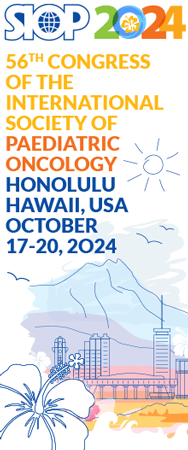1986 Mrs Lorie Grundy RN, Children’s Hospital of Philadelphia, USA
“What are the costs of cure in childhood acute non-lymphoblastic leukaemia?”
1987 Dr Linda S Lashford, Institute of Child Health, London, UK
“Systemic administration of radionuclides in neuroblastoma as planned radiotherapeutic intervention”
1988 Dr Christopher D Mitchell, Institute of Child Health, London, UK
“A molecular genetic study of chromosomal deletions and translocation within and around 4.7R locus – A candidate for the retinoblastoma susceptibility gene”
1989 Dr David L Baker et al, Children’s Hospital of Philadelphia, USA
“Analysis of NGF receptor expression in human Neuroblastoma and Neuro-epithelioma cell lines”
1990 Dr François Doz, Brain Tumor Research Center, California, USA
“Experimental basis for increasing the therapeutic index of carboplatin in brain tumor chemotherapy”
1991 Dr Kathryn Pritchard Jones, Medical Research Council Human Genetics Unit, Edinburgh, UK
“Cell types expressing the Wilms’ tumour gene (WT1) in Wilms’ tumours: implications for tumour histogenesis”
1992 Dr R Pieters, Free University Hospital, Department of Paediatrics, De Boelelaan 1117, 1081 HV Amsterdam, The Netherlands.
“Clinical Relevance of in vitro drug resistance testing in childhood acute lymphoblastic leukaemia (ALL): the state of the art”
1993 Dr Huib N. Caron 1, 2
1 Institute of Human Genetics, Academic Medical Centre, University of Amsterdam, Meibergdreef 15, 1105 AZ Amsterdam, The Netherlands
2 Dept. of Paedriatric Oncology and Haematology, Emma Kinderziekenhuis/ Academic Medical Centre, University of Amsterdam.
”In neuroblastoma allelic loss of chromosome 1p and the presence of additional chromosome 17q material are both associated with an unfavourable outcome.”
1994 Dr Richard G Grundy, ICRF Oncology Group, Institute of Child Health, 30 Guilford Street, London WC1N 1EH, UK.
“A molecular genetic study of Perlman syndrome – another piece of the ’Wilms’ jigsaw!”
1995 Dr Stefaan W. Van Gool, Pediatric Oncology, U.Z. Gasthuisberg, Herestraat 49, B-3000 Leuven, Belgium.
”Inhibition of cytotoxic T cell activity, and induction of alloantigen-specific anergy by blocking both CD28 interaction with its ligands and calcineurin”
1996 Dr. M. Heyman, Karolinska Hospital, 17176 Stockholm, Sweden
“Prognostic importance of p15INK4B and p16INK4 gene inactivation in childhood acute lymphocytic leukemia”
1997 Dr. Rani E. George, MRC Clinical Training Fellow, Cancer Research Unit, Newcastle University Medical School, Newcastle upon Tyne, UK NE1 4HH, United Kingdom
“DDX1 gene co-amplification with MYCN in neuroblastoma: clinical and biological significance”
1998 Dr. R.J. Gilbertson, MRC Clinical Research Fellow, Cancer Research Unit, The Medical School, Framlington Place, University of Newcastle upon Tyne, Newcastle upon Tyne, NE2 4HH, United Kingdom
“The biological and therapeutic significance of the ErbB-Neuregulin signalling network in childhood medulloblastoma“
1999 Dr. H. Sietsma, Department of Pediatric Oncology, Beatrix Children’s Hospital, University Hospital Groningen, P.O. Box 30.001, 9700 RB Groningen, The Netherlands.
”Increased sensitivity of neuroblastoma cells for taxol and vincristine by PDMP; involvement of ceramide”
2000 Dr. A. Eggert, Division of Oncology, The Children’s Hospital of Philadelphia and Department of Pediatrics, The University of Pennsylvania, Philadelphia, PA 19104, University Children’s Hospital of Essen, Germany and University Children’s Hospital of Zurich, Switzerland
“Expression of neurotrophin receptor TrkA inhibits angiogenesis in neuroblastoma”
2001 Dr. J. Mora, Departments of Pediatrics and Molecular Pathology, Memorial Sloan–Kettering Cancer Center,New York, NY 10021 U.S.A.
”Differentiated neuroblastic and Schwannian cells of neuroblastoma are derived from a common tumoral stem cell progenitor”
2002 Dr. S. Fulda, Universitätsklinikum Ulm, Universitätskinderklinik und Poliklinik, Prittwitzstrasse 43, 89075 Ulm, Germany
”Smac agonists sensitize for Apo2L/TRAIL- or anticancer drug-induced apoptosis and induce regression of malignant glioma in vivo”
2003 Dr. Aru Narendran, Southern Children’s Cancer Program, Alberta Children’s Hospital, Calgary, Canada
“Molecular changes in bone marrow stroma as a supportive mechanism for the proliferation of acute lymphoblastic leukemia”
2004 Dr. U. Kreicbergs, Clinical Cancer Epidemiology, Karolinska Institut/Hospital Z6:01 SE-171 76 Stockholm, Sweden
”Care related distress in parents losing a child to cancer: A population – based long-term follow-up”
2005 Prof. M.D. Taylor, Division of Neurosurgery, Hospital for Sick Children, University of Toronto, Suite 1504, 555 University Avenue, Toronto, Ontario, Canada M5G 1X8
”Distinct origins and subtypes of ependymoma revealed by genomic profiling of human and mouse tissues”
2006 Dr. Stefan Grotegut, Switzerland
“Hepatocyte growth factor/scatter factor induces cell scattering through MAPKdependent upregulation of Snail“
2007
2008 Dr. B. Das, Canada
“Tumour initiating fraction of neuroblastoma and rhabdomyosarcoma sind-population dells migrate and expand in the hypoxic niche in vivo”
2009 Dr. D.Stumpel
“Specific promoter methylation identifies different subgroups of MLL-rearranged infant Acute Lymphoblastic Leukemia influences clinical outcome and provides therapeutic options”
2010 Dr. A.A. Nageswara Rao, United States
“Therapeutic doses of ionizing radiation induce hippocampus-dependent cognitive deficits in young mice”
2011
2012 Dr. A. Takatori, Division of Biochemistry & Innovative Cancer Therapeutics, Children Cancer Research Center, Chiba Cancer Center Research Institute, 666-2 Nitona-cho, Chuoh-ku, Chiba 260-8717, Japan
“NLRR1, a direct target of MYCN, promotes cell growth both in vitro and in vivo and can be a therapeutic target against high-risk neuroblastoma”
2013 Meenakshi Hegde, Center for Cell and Gene Therapy, Baylor College of Medicine, 1102 Bates Street MC 3-3320, Houston, TX 77030, US“Combinational targeting offsets antigen escape and enhances effector functions of adoptively transferred T cells in High Grade Glioma (HGG)”
2014, Jocelyn Charlton, UCL Institute of Child Health in partnership with Great Ormond Street Hospital for Children NHS Trust, London, United Kingdom “DNA Methylation in Wilms tumours identifies alterations associated with nephrogenic rest formation, tumourigenic progression and tumour biomarkers in patient blood”
2015, Derek Oldridge, University of Pennsylvania, School of Medicine, USA, “Genetic predisposition to neuroblastoma mediated by a LMO1 oncogene super-enhancer polymorphism”
2016, Jonathon Torchia, University of Toronto, Laboratory Medicine and Pathobiology, Canada, “Integrated genomic and epi-genomic analyses identify sub-group specific therapeutic targets in CNS rhabdoid tumors”
2017, Kristopher Bosse, Children’s Hospital of Philadelphia, USA, “Identification of GPC2 as an oncogene and candidate immunotherapeutic target in highrisk neuroblastoma”
2018, Guillem Pascual-Pasto, Institut de Recerca Sant Joan de Deu, Barcelona, Spain, “Therapeutic targeting of the Rb/E2F-1 pathway in retinoblastoma with the oncolytic adenovirus VCN01”
2019, Amaury Leruste, Institut Curie, France, “Clonally expanded T cells reveal immunogenicity of rhabdoid tumors”
2020, Jiil Chung, Hospital for Sick Children & University of Toronto, Canada, “DNA POLYMERASE AND MISMATCH REPAIR EXERT DISTINCT MICROSATELLITE INSTABILITY
SIGNATURES IN NOMRAL AND MALIGNANT HUMAN CELLS”
2021, Anirban Das, The Hospital for Sick Children, Canada, “MUTATION AND MICROSATELLITE BURDEN PREDICT RESPONSE TO PD-1 INHIBITION IN CHILDREN WITH GERMLINE DNA REPLICATION REPAIR DEFICIENCY”
2022, Han Wang, The Chinese University of Hong Kong, Hong Kong, “Integrative drug and genomic profiling identify therapeutic vulnerabilities and inform
precision medicine for pediatric acute myeloid leukemia”
2023, Eline Johanna Maria Bertrums, Princess Máxima Center for Pediatric Oncology, Utrecht, the Netherlands, “Selective pressures of platinum compounds shape the evolution of therapy-related myeloid neoplasms.”




